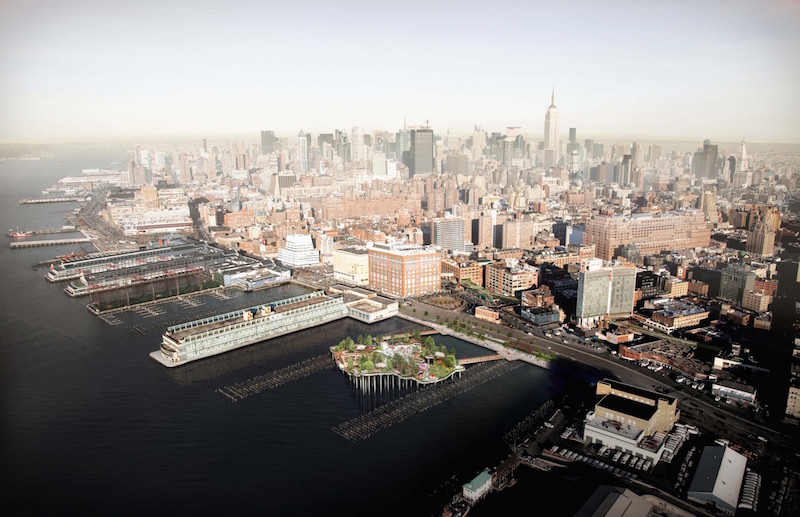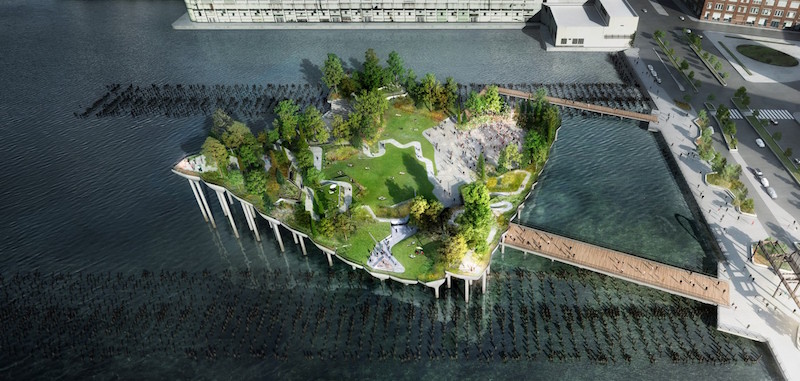Pier 55, a 2.7 acre park rising above the Hudson River on Manhattan’s lower west side, can move forward without hesitation as the New York Court of Appeals has denied City Club of New York’s motion for leave.
The park, whose construction is being privately funded by Diane Von Furstenberg and Barry Diller, has been embroiled in a legal battle almost from the moment of its conception.
The City Club brought forth the lawsuit arguing that just because the project is being privately funded, that doesn’t mean the basic rules of environmental review, public involvement, and the need for competitive bidding can be ignored. City Club also takes issue with the fact that the park will sit atop 550 piles and rise as high as seven stories above the water, fully obscuring a wide-open view of the Hudson.
City Club’s brief focused on the following issues:
- Failure to do an environmental impact statement
- Failure to study cumulative impacts of two related projects, Piers 55 and 57
- Failure to obtain competitive bids
- Failure to comply with legislation to allow reconstruction of Pier 54
- Failure to apply the public trust doctrine, particularly to ensure open public access
City Club says it got into the case because the project illustrates a city-is-for-sale mentality, is illegal under the terms of the Park Act, and bypassed environmental protection laws.
However, the most recent ruling from the Appellate Division may be the end of the lawsuit once and for all, as the Court of Appeals was one of the group’s final avenues for delaying the project, Curbed New York reports.
In a statement, Hudson River Park Trust President & CEO Madelyn Wils referred to the lawsuit as “ill-conceived” while expressing excitement over being able to continue construction on “one of the city’s most spectacular new public spaces.”
 Rendering courtesy of Heatherwick Studio
Rendering courtesy of Heatherwick Studio
 Rendering courtesy of Heatherwick Studio
Rendering courtesy of Heatherwick Studio
Related Stories
Urban Planning | Feb 14, 2022
5 steps to remake suburbs into green communities where people want to live, work, and play
Stantec's John Bachmann offers proven tactic for retrofitting communities for success in the post-COVID era.
Urban Planning | Feb 11, 2022
6 ways to breathe life into mixed-use spaces
To activate mixed-use spaces and realize their fullest potential, project teams should aim to create a sense of community and pay homage to the local history.
Urban Planning | Jan 25, 2022
Retooling innovation districts for medium-sized cities
This type of development isn’t just about innovation or lab space; and it’s not just universities or research institutions that are driving this change.
Urban Planning | Dec 15, 2021
EV is the bridge to transit’s AV revolution—and now is the time to start building it
Thinking holistically about a technology-enabled customer experience will make transit a mode of choice for more people.
Designers / Specifiers / Landscape Architects | Nov 16, 2021
‘Desire paths’ and college campus design
If a campus is not as efficient as it could be, end users will use their feet to let designers know about it.
Urban Planning | Nov 11, 2021
Reimagining the concrete and steel jungle, SOM sees buildings that absorb more carbon than they emit
The firm presented its case for a cleaner built environment during the Climate Change conference in Scotland.
Urban Planning | Aug 16, 2021
Building with bikes in mind: How cities can capitalize on the pandemic’s ‘bike boom’ to make streets safer for everyone
Since early 2020, Americans have been forced to sequester themselves in their homes with outdoor activities, in most cases, being the sole respite for social distancing. And many of people are going back to the basics with a quintessential outdoor activity: biking. Bike sales absolutely skyrocketed during the pandemic, growing by 69% in 2020.
Resiliency | Jun 24, 2021
Oceanographer John Englander talks resiliency and buildings [new on HorizonTV]
New on HorizonTV, oceanographer John Englander discusses his latest book, which warns that, regardless of resilience efforts, sea levels will rise by meters in the coming decades. Adaptation, he says, is the key to future building design and construction.
Urban Planning | May 3, 2021
SWA/Balsley unveils Nelson Mandela Park Master Plan for Rotterdam
The conceptual plan provides much-needed central neighborhood and civic open space in the city’s South Maashaven district.
University Buildings | Apr 29, 2021
The Weekly Show, April 29, 2021: COVID-19's impact on campus planning, and bird management strategies
This week on The Weekly show, BD+C Senior Editor John Caulfield interviews a duo of industry experts on 1) how campus planning has changed during the pandemic and 2) managing bird infestations on construction sites and completed buildings.










![Oceanographer John Englander talks resiliency and buildings [new on HorizonTV] Oceanographer John Englander talks resiliency and buildings [new on HorizonTV]](/sites/default/files/styles/list_big/public/Oceanographer%20John%20Englander%20Talks%20Resiliency%20and%20Buildings%20YT%20new_0.jpg?itok=enJ1TWJ8)






